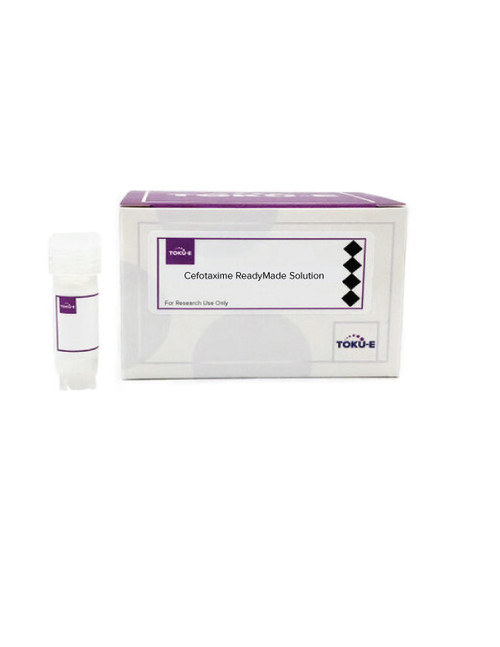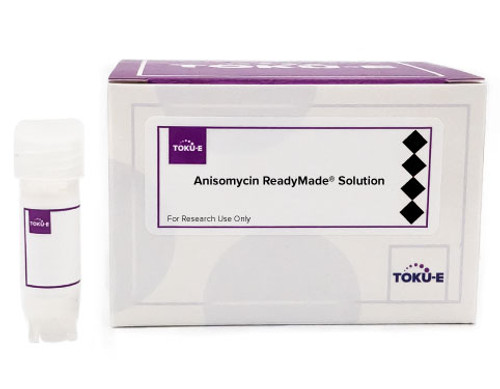Bleomycin ReadyMade™ Solution is provided as a sterile-filtered solution of Bleomycin Sulfate formulated in water at a concentration of 10 mg/ml.
Bleomycin is a natural product, a complex of 11 glycopeptide antibiotics originally isolated from Streptomyces verticillus in 1962 by Japanese scientist Hamao Umezawa. The dominant isomers are Bleomycin A2 and Bleomycin B2, which typically represent >90% of the total weight. The approximate composition of A2:B2 is 2:1. Bleomycin has anti-cancer properties, and has been used in COVID-19 research.
We also offer:
- Bleomycin Sulfate, USP (B005)
| Mechanism of Action | Bleomycins act by intercalation of DNA and RNA. In the presence of oxygen and metal ions, notably copper and iron, Bleomycins form a pseudo-enzyme that induces DNA cleavage. Bleomycin's anticancer activities include the increase of caspase-3 and p53, and the inhibition of telomerase activity leading to apoptosis. The anti-cancer properties derives from its ability to effect DNA cleavage in cancer cells. |
| Spectrum | Bleomycin is used as a selective agent for Gram-negative and Gram-positive bacteria. |
| Plant Biology Applications | Bleomycin can be used as a selectable marker for plant cell transformation with Nicotiana plumbaginifolia using Agrobacterium tumefaciens. The expression of this determinant confers resistance to Bleomycin and allows selection of transformed plant cells (Hile et al, 1986). |
| Microbiology Applications |
Bleomycin has been used to induce chronic lung disease in animal models to study antifibrotic therapy for COVID-19 (SARS-CoV-2). |
| Eukaryotic Cell Culture Applications |
Bleomycin can be used as a selection agent in different cell lines. Recently, mesenchymal stem cells (MSc) secretome has been used as a strategy for COVID-19. Evidence from murine models indicate that he secretome can be used for pulmonary injuries induced wiith Bleomycin, due to its content: growth factors, extracellular vesicles, and exosomes. The MSc secretome testing and production in xenofree conditions could be used as an alternative approach for SARS-Cov-2 treatement in vivo (Deffune et al, 2020). |
| Cancer Applications | Bleomycin contains a disaccharide moiety composed of 2 unusual sugars, L-glucose and 3-O-carbamoyl-D-mannose. Bleomycin could be regarded as a modular system composed of a tumor-targeting agent (the dissacharide moiety) and a tumoricidal agent (deglycobleomycin). The disaccharide moiety is responsible for the tumor cell targeting properties of Bleomycin. Bleomycin analogs were prepared, the glycosylated analogs were more cytotoxic to cultured DU145 prostate cancer cells. These findings establish a role for the Bleomycin disaccharide in tumor targeting/uptake and suggest that the disaccharide moiety may be capable of delivering other cytotoxins to cancer cells. Cytotoxicity testing with DU145 human prostate cancer cells in vitro (Schroeder et al, 2014).
Bleomycin is used in combination with other antineoplastic agents in studying lymphomas, testicular carcinomas, and squamous cell carcinomas. Authors found that the human L-carnitine transporter (hCT2) is involved in bleomycin-A5 uptake. NT2/D1 human testicular cancer cells which highly express hCT2 are very sensitive to Bleomycin-A5. Data suggest that hCT2 can mediate the uptake of Bleomycin A5 (Aouida et al, 2010). In cell culture experiments with Bleomycins and BLM carbohydrates conjugated to microbubbles, it has been demonstrated that Bleomycins are tumor-seeking molecules. Biotinylate Bleomycin A5 was attached to microbubbles, and a conjugate-containing solution was passed over a monolayer of MCF-7 cells. The microbubbles adhered to the MCF-7 cells. The conjugate did not bind to a normal breast cell line or to matched noncancer cell lines. No binding occurred if the microbubbles lacked conjugated Bleomycin A5 or if the microbubble lacked the carbohydrate moiety (Chapuis et al, 2009). A well-known characteristic of tumor cells is the Warburg effect, that is the propensity of tumor cells to produce increased ATP via glycolysis rather than by mitochondrial oxidative phosphorylation. The shift to glycolysis is accompanied by upregulation of glucose transporters to provide the greater amounts of glucose needed to support increased glycolysis. If authors treated two normal cell lines (normal WI-38 cells and normal kidney CCD-1105 KIDTr cells) with the inhibitor rotenone (a mitochondrial complex 1 inhibitor), this forced these cells to use increase glycolysis in the same fashion as tumor cells and this resulted in an enhanced ability to incorporate BLM-Cy5. The finding implies that the BLM saccharide moiety may be able to deliver other cytotoxins selectively to tumor cells (Mobasheril, 2005). |
| Molecular Formula | C55H84N17O21S3 (Bleomycin A2); C55H84N20O21S2 (Bleomycin B2) |
| References |
Aouida M, Poulin P and Ramotar (2010) The human carnitine transporter SLC22A16 mediates high affinity uptake of the anticancer polyamine analogue Bleomycin-A5. J. Biol. Chem. 285:6275-6284 Burger RM, Paisach J, and Horwitz SB (1981) Mechanism of Bleomycin action: In vitro studies. Life Sci. 28(7):715-727 PMID 6164898 Chapuis J, Schmaltz RM, Tsosie KS, Belohlavek M and Hecht SM (2009) Carbohydrate dependent targeting of cancer cells by Bleomycin-microbubble conjugates. J. Am. Chem. Soc. 131(7):2438-2439 Defune E, Prudenciatti A and Moroz A (2020) Mesenchymal stem cell ({MSc) secretome: A possible therapeutic strategy for intensive-care COVID-19 patients. Med. Hypotheses 142:109769 Dorr RT (1991) Bleomycin Pharmacology: Mechanism of action and resistance, and clinical pharmacokinetics. Semin. Oncol. 19(2): 3-8 PMID 1384141 Fujiwara Y and Kondo T (1973) Strand-scission of HeLa cell deoxyribonucleic acid by Bleomycin in vitro and in vivo. Biochem. Pharmacol 22(3):323-333 PMID 4119868 Hile J et al (1986) Bleomycin resistance: A new dominant selectable marker for plant cell transformation. Plant Molec. BIol 7:171-176 Kross et al (1982) Structural basis for the deoxyribonucleic acid affinity of Bleomycins. Biochem. 21: 3711-3721 PMID 6180763 Kross et al (1982) Specificity of deoxyribonucleic acid cleavage by Bleomycin, phleomycin and tallysomycin. Biochem. 21:4310 PMID 6181807 Mobasheril, A, Richardson S, Mobasheri R, Shakibaei M, Hoyland, J (2005) Hypoxia inducible factor-1 and facilitative glucose transporters GLUT1 and GLUT3: Putative molecular components of the oxygen and glucose sensing apparatus in articular chondrocytes. Histol. Histopathol. 20(4):1327-1338 PMID 16136514 Mulsant P, Gatignol A, Dalens M and Tiraby, G (1988) Phleomycin resistance as a dominant selectable marker in CHO cells. Som. Cell and Mol. Gen. 14(3):243–252 PMID: 2453083 Schroeder BR et al (2014) The disaccharide moiety of Bleomycin facilitates uptake by cancer cells. J. Am. Chem Soc. 136(39):13641-13656 Takita T et al (1972) Chemistry of Bleomycin. IX. The structures of Bleomycin and phleomycin. J. Antibiot. (Tokyo) 25:755-757 PMID 4119701 Yang L, Yang S, Tai K, Chou M and Yang J (2004) MEK inhibition enhances Bleomycin A5-induced apoptosis in an oral cancer cell line: Signaling mechanisms and therapeutic opportunities. J. Oral Path. and Med. 33(1):37-45 |












